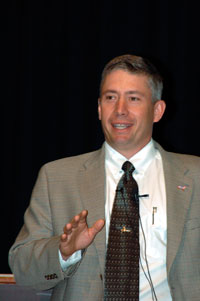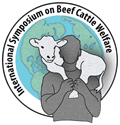Benchmarking Animal Welfare Progress
When encouraging those in the beef industry to make changes to improve animal well-being, measured outcomes can provide the reason why.
MANHATTAN, Kan. (May 21, 2010) — Dan Thomson, professor and director of the Beef Cattle Institute at Kansas State University, posed the question, “Why do we need to measure outcomes?” as he addressed the International Symposium on Beef Cattle Welfare May 20 on the campus of Kansas State University.

"We need to be a more proactive industry," Dan Thomson says. "We've got to define what normal is so we know what abnormal is."
Thomson replied, “Because when you are asking people to make changes, they are going to ask ‘Why?’” Having measured outcomes can give a basis for the animal well-being recommendations that are made.
Additionally, Thomson emphasized that when making recommendations for animal well-being and animal husbandry, consideration needs to be given to what producers are being asked to implement. “There is a practical application that has to be met,” he stated.
The areas that Thomson suggested the industry focus on documenting include:
• labor and training;
• implementation of standard operating procedures (SOPs); and
• statistical process control.
“We need to be a more proactive industry." Thomson said. "We’ve got to define what normal is so we know what abnormal is.”
As an illustration of this, he explained, “One number, such as mortality rates, doesn’t do a good job of describing what’s going on. Statistical process control allows for explaining why things happen so we can be proactive and prevent the incident from happening again versus being reactive.”
Looking to the future, Thomson also talked about some of the shifts in thinking that may be necessary.
“Animal welfare should not be competitive (i.e., my animal welfare practices are better than yours)," he said. "Instead, the beef industry needs to formalize one welfare assessment tool.”
Expanding on that thought, Thomson said in his view producer groups know what’s best.
“I don’t think government regulation is the way to go," he said. "SOPs and assessment tools and third-party audits can be an effective system for ensuring animal well-being practices are implemented.” He suggested this may be an ideal role for rural practitioners because they know the producers.
Another shift that Thomson indicated the industry may need to adapt is beef quality audits and where they occur.
“The audits used to be about physical qualities of the meat. Now animal handling and herd management are moving up in importance on that list. Maybe we need to start doing a feeder calf audit for animal well-being. That’s a shift,” Thomson said.
Thomson highlighted an online training center focused on animal care that K-State has initiated at www.animalcaretraining.com. The site offers 200 modules in Spanish and English on beef, dairy and equine animal care, behavior and handling topics. Eight of the modules are specifically designed as training for livestock auction market employees with a post test at the end.
Thomson emphasized how tools such as this can help ensure proper animal well-being training and documentation of that training to help implement a proactive change in the beef industry.
In closing, Thomson acknowledged that, “Nobody cares more about cattle than the people who get up and take care of them every day. … I’m humbled to be a part of that.”
He then challenged the industry to pick two or three issues and improve them.
“You can’t eat an elephant in one bite,” he said, explaining that a list of 100 items becomes worthless because you can’t change them all. “You’ve got to pick two or three things and then, as an industry, over three, five or 10 years make a change.”
As an example, he pointed how the industry focused on injection-site lesions several years ago and was able to greatly reduce the problem.
“In the last two years, I’ve seen the beef industry accept change, create more transparency and focus on improving the industry with regard to animal welfare," Thomson concluded. "But, like any good team, we want to continue to get better every day. We have a lot of people and cattle counting on us.”
The beef cattle welfare symposium was conducted on campus at K-State University May 19-21. For additional presentation summaries, return to the Meetings > Other Industry Meetings > News Coverage page of the API Virtual Library. For more about the symposium and an archive to the 2008 symposium, visit www.isbcw.beefcattleinstitute.org.
Editor's Note: This article was written under contract or by staff of Angus Productions Inc. (API), which claims copyright to this article. It may not be published or distributed without the express permission of API. To request reprint permission and guidelines, contact Shauna Rose Hermel, editor, at 816-383-5270.

